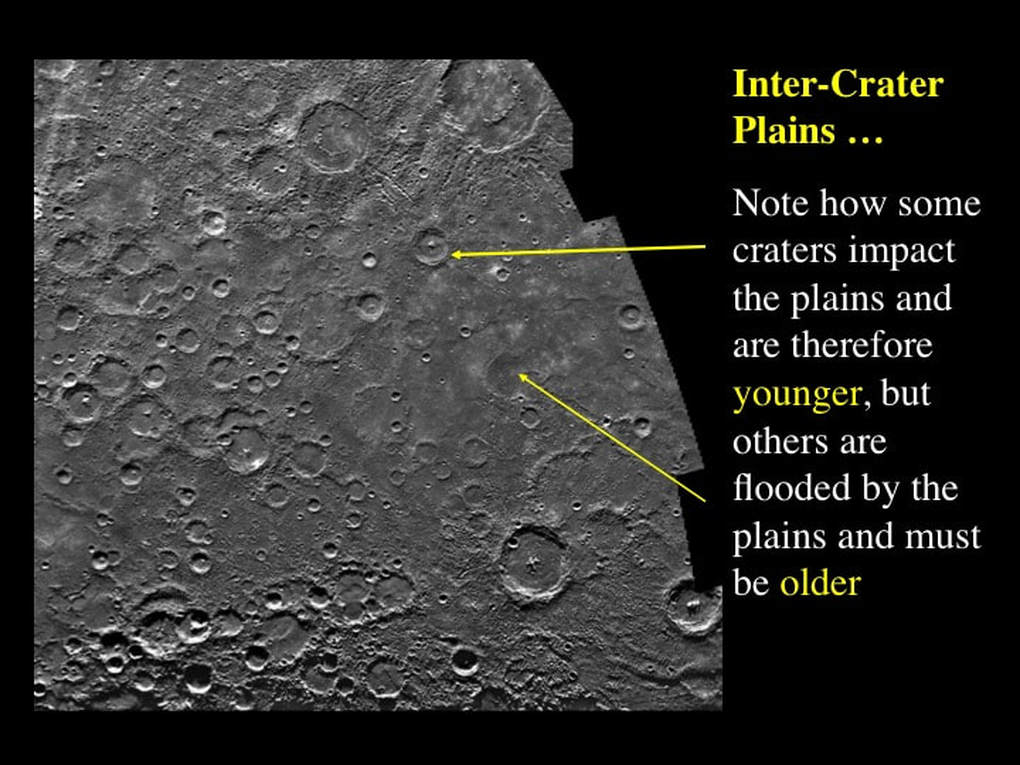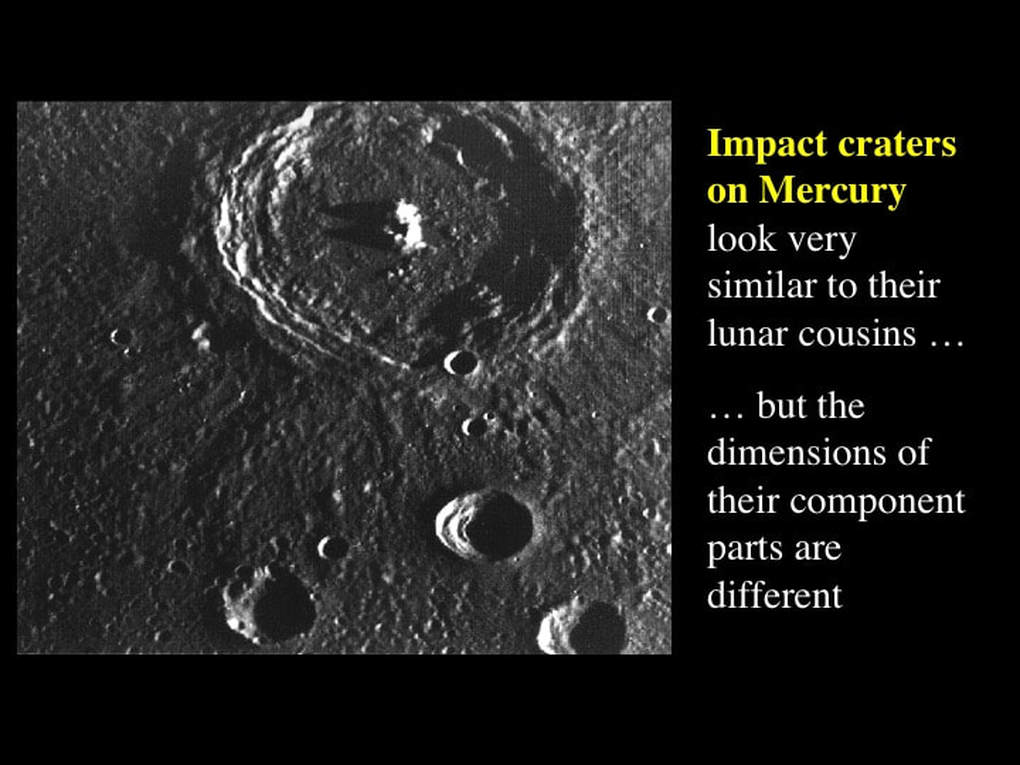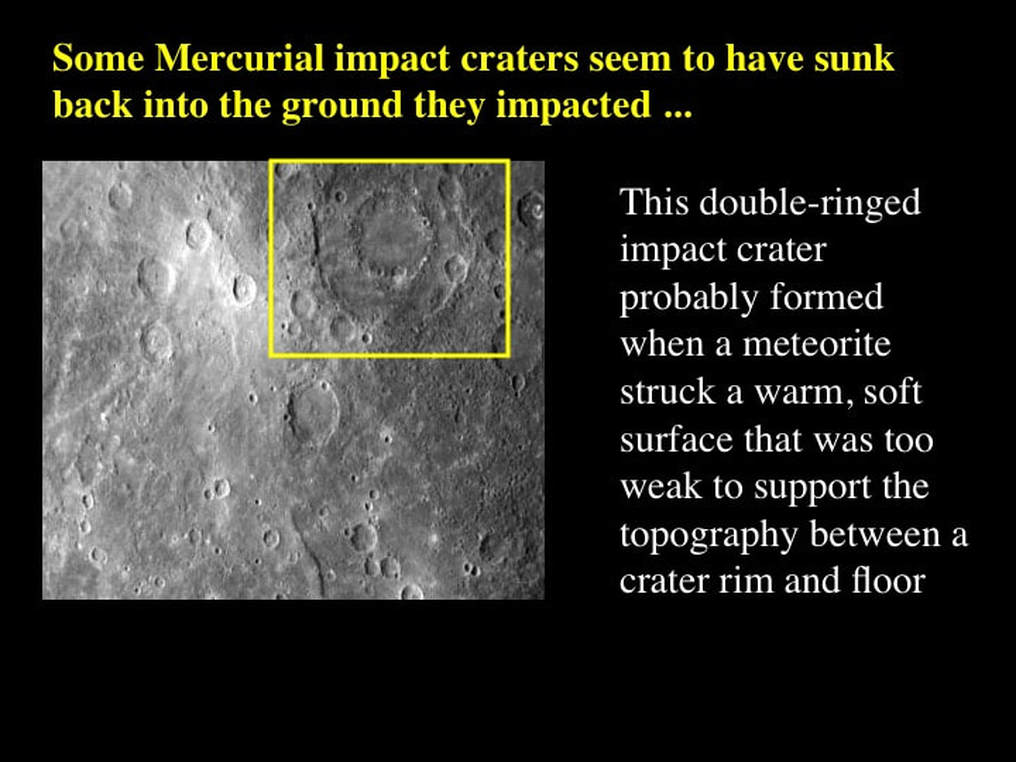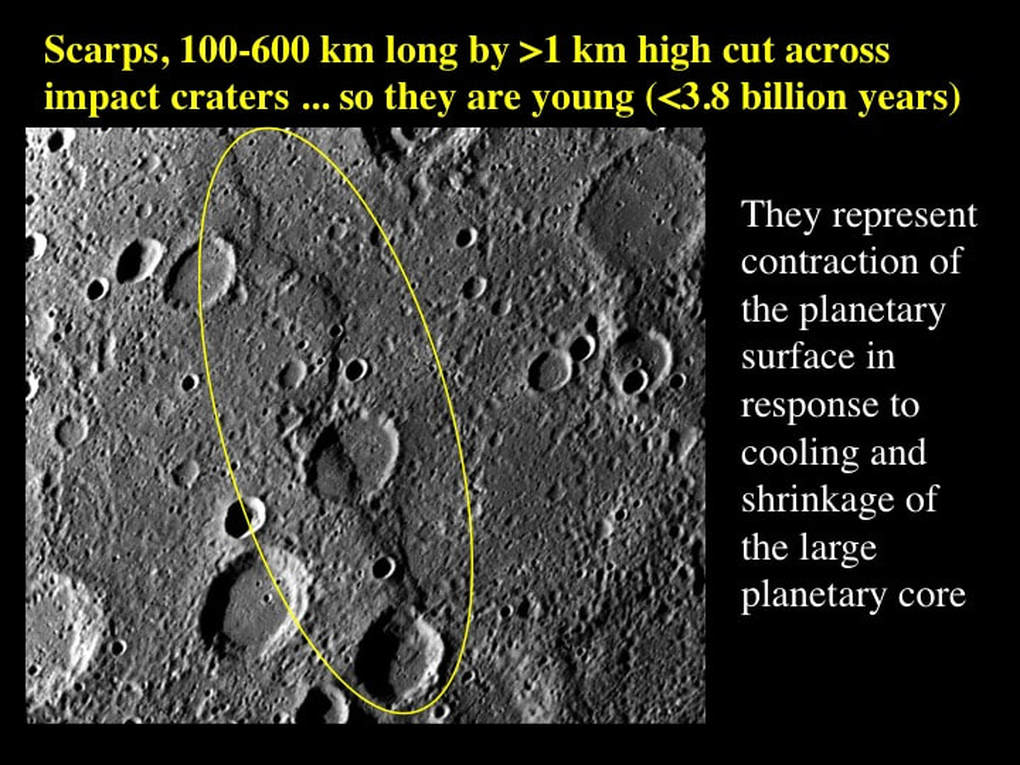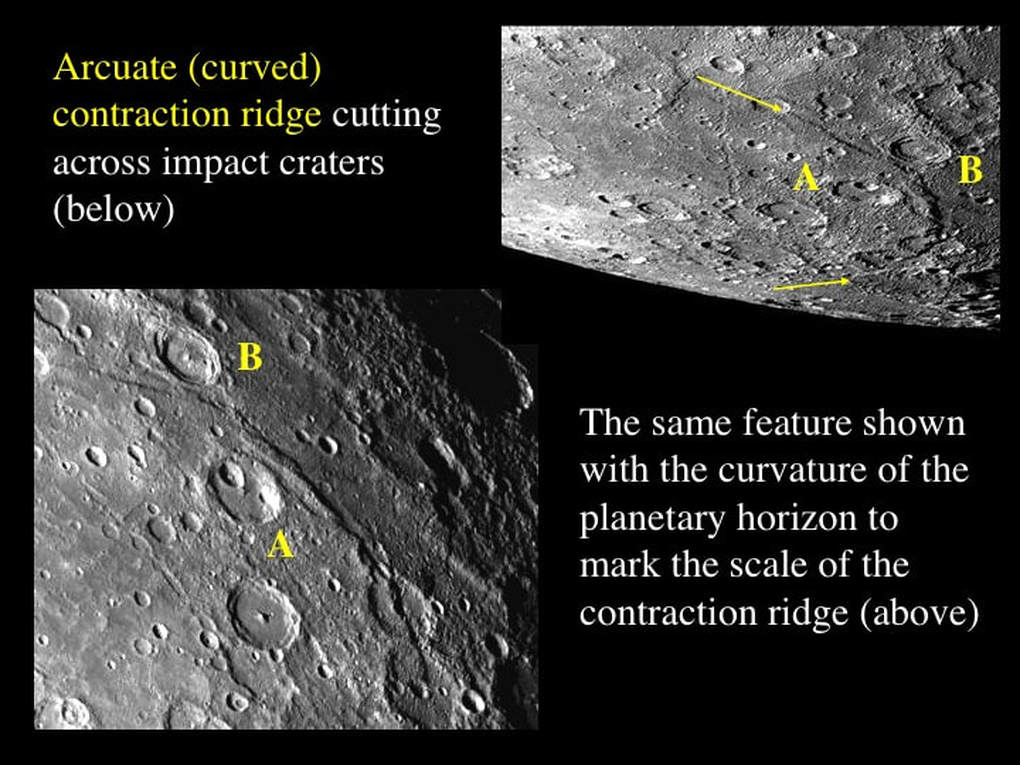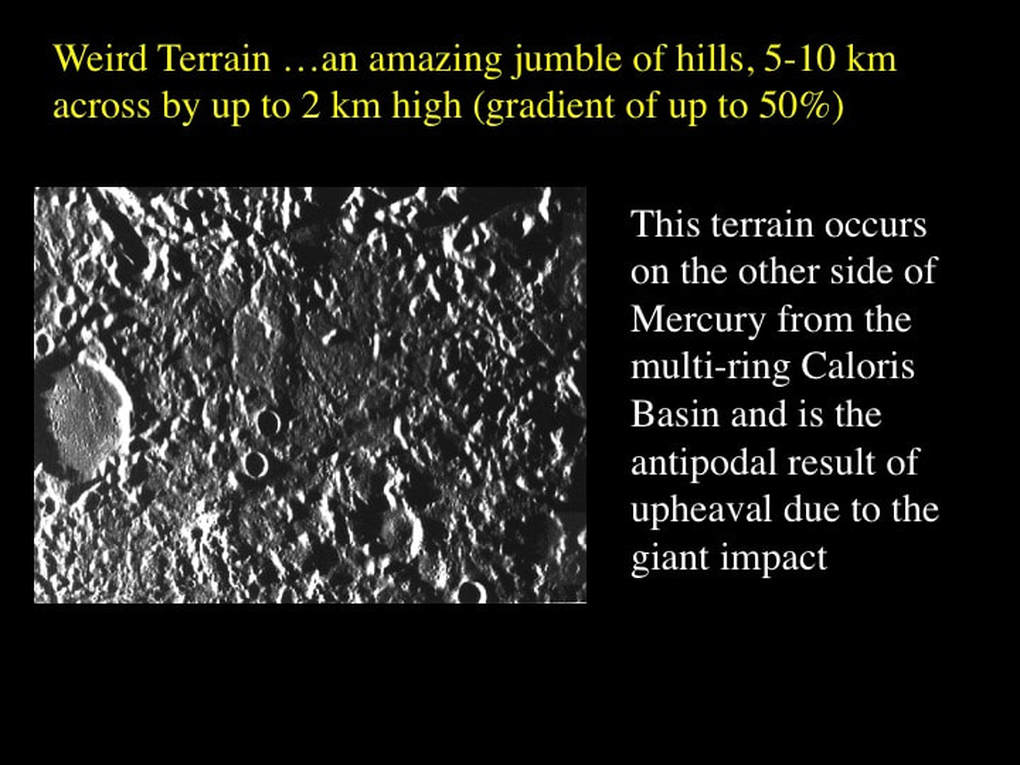|
MERCURY
|
Planetary Science has progressed by leaps and bounds in the past few years. We’ve sent probes to all the outer planets, except for Pluto. Our detailed photographic coverage of Mars from orbiting probes is almost as good as our coverage of Earth. We’ve now detected over 100 extra-solar planetary systems and we’re only a few steps away from actually imaging them. So it’s ironic that a planet we can see with the naked eye for much of the calendar year is so poorly imaged, so poorly known, and its planetary geology is so poorly understood. All the images we have of Mercury come from the unmanned Mariner missions of the mid-1970’s, principally Mariner 10 in 1974-75. Although there were 3 fly-by’s by Mariner 10, because of the orbital mechanics of the probe and the planet Mariner always saw the same hemisphere illuminated by the Sun.
The orbital mechanics of Mercury are unique among the planets, but very similar to those of the moons of the outer Solar System. Because Mercury is so close to our star, the Sun exerts an enormous gravitational pull, raising powerful tidal forces within the rocks that make up the planet. The result is that Mercury’s rotation around its own axis has slowed down to synchronise with its orbit around the Sun, such that it now takes 2 complete orbits around the Sun to complete 3 rotations about its own axis. In other words, there are 3 mercurial days for every 2 mercurial years ! We only discovered the rotational behaviour of Mercury in the 1960’s thanks to radar. Before that, visual observations from Earth produced some very crude maps of the planet’s surface : crude, and mostly imaginary like this famous example from the mid-1930’s by a Greek astronomer by the name of Antoniadi.
In case you’re wondering why we don’t use Hubble to fill in the missing images, NASA won’t allow it because of Mercury’s proximity to the Sun, any navigational errors could potentially be fatal for the ‘scope if it should accidentally look directly at the Sun !
In case you’re wondering why we don’t use Hubble to fill in the missing images, NASA won’t allow it because of Mercury’s proximity to the Sun, any navigational errors could potentially be fatal for the ‘scope if it should accidentally look directly at the Sun !
Before we look at what the surface of Mercury tells us about its planetary geology, let’s look at the big picture. In terms of its size, Mercury lies somewhere between Mars and our own Moo. In fact it’s exactly the same size as Jupiter’s moon Callisto. However, from studying the effect of the gravitational pull of Mercury on the Mariner probes, planetary scientists calculate that Mercury is almost as dense as its much larger neighbours, Earth and Venus.
This presents planetary geologists with a difficult conundrum. In order to be small and dense, Mercury must contain a very large, very heavy core of iron and nickel that spans 75% of its diameter. So far, so good ! The trouble is, if you remember my series of presentations on meteorites, planetary bodies form by the clumping together or “accretion” of smaller bodies made of primitive meteorite stuff (or chondrite) that heats up and “differentiates” into a core, a mantle and a crust. The problem is that when primitive chondritic material differentiates, it only yields a small amount of iron and nickel relative to the size of the planet - certainly not 75% ! So what’s the explanation ?
The trouble is, if you remember my series of presentations on meteorites, planetary bodies form by the clumping together or “accretion” of smaller bodies made of primitive meteorite stuff (or chondrite) that heats up and “differentiates” into a core, a mantle and a crust. The problem is that when primitive chondritic material differentiates, it only yields a small amount of iron and nickel relative to the size of the planet - certainly not 75% ! So what’s the explanation ?
lWell, the answer is not going to be straight-forward ! Mercury presents planetary geologists with a complicated problem. Two principal theories have been proposed to account for the relatively large planetary core - and I’ll tell you right now - neither of them work ! #1: some suggest that the heavy bombardment by meteorites during the accretionary phase of the Solar System smashed the outer layers of a much larger planet, leaving its core and a thin relict mantle behind. #2: others suggest that, because Mercury formed so close to the early Sun, it’s outer layers were volatilised by the energy pumped out by the star at the centre of the evolving Solar System.
The problem is that by analysing the light reflected from the planet, the surface of Mercury appears to be made of the same stuff as the surface of our own Moon, a rock called anorthosite that is made of the same stuff as “CoffeeMate”, a calcium aluminium silicate ! This is exactly the rock that planetary science predicts should form the primitive crust - or outermost layers - of a normally differentiated planet. In other words, while Mercury may be anomalously heavy on the inside, it appears to be perfectly normal on the outside. So whatever the explanation for the anomalously large core turns out to be, it apparently has nothing to do with stripping off the external layers of a once much larger planet. Well, that’s most unfortunate, because current planetary theory doesn’t offer us any other explanations !
So what does Mercury’s surface look like ? Superficially, surface features on Mercury resemble those on Earth’s Moon, with heavily cratered terrains vs flatter, smoother plains, and many texts will emphasise this. In fact, not only does Mercury have one of the largest giant Impact Basins in the Solar System - Caloris Basin, some 1300 Km in diameter - but superficially it looks just like the huge Orientale Impact Basin that is mostly hidden from us on the west side of the Moon. Note the multiple rings in both cases: these represent really big impacts ! However, when you look a bit more closely and start making measurements, the apparent similarities between Mercury and the Moon give way to differences !
Perhaps the biggest difference is the way the cratered and smooth terrains are distributed. On the Moon the smooth terrains are the dark “Mare” that are sharply delimited from the lighter heavily cratered Highlands. This colour difference reflects the fact that the dark “Mare” are made of basalt lava that occurs all over the side of the Moon that always faces the Earth, while the light coloured Highlands are made of anorthosite - the “CoffeeMate” rock.
However, on Mercury the Smooth Plains (as they are officially called) are all concentrated in one place : they form the floor inside the Caloris Impact Basin, and a collar around its perimeter. Now here’s where it gets interesting …
In contrast to the lunar “Mare”, the Smooth Plains on Mercury are the same colour and therefore the same composition as the Heavily Cratered Terrain, so some planetary geologists have suggested that they are not made of lava, but are formed of fine grained debris derived from the impact that made the Caloris Basin. Well, life is never that simple in planetary geology and it turns out that, by measuring the number and size of impact craters, the Smooth Plains are not only relatively young in the history of Mercury, but they are much younger than the impact that made the Caloris Basin. So, whatever the Smooth Plains are really made of, they did not form during the major impact event that sculpted the surface of Mercury as we see it today.
Remember that the the major impacts that formed the craters and giant Impact Basins throughout the Solar System occurred during the “Heavy Bombardment” between ~4,0 and 3.8 billion years ago - so “relatively young” is anything younger than 3.8 billion years old !
Remember that the the major impacts that formed the craters and giant Impact Basins throughout the Solar System occurred during the “Heavy Bombardment” between ~4,0 and 3.8 billion years ago - so “relatively young” is anything younger than 3.8 billion years old !
Another major contrast between the Moon and Mercury is that unlike the Moon, Mercury has a second set of flat terrains called the “Inter-Crater Plains”. These plains are impacted by lots of craters and are therefore relatively old, but right next door, the same Inter-Crater Plains can flood and drown other impact craters, so the plains are relatively young ! The obvious conclusion here is that the Inter-Crater Plains formed during the Heavy Bombardment, about 4 billion years ago : another major difference with the Moon !
Now let’s look at the impact craters themselves. Again - superficially - they look just like those of the Moon, with central peaks, flat floors and terraced walls characteristic of the larger examples ...
... but the transition to these mature crater forms occurs at smaller sizes on Mercury, the stuff thrown out of the hole by the impact didn’t travel as far from the crater as on the Moon, and the bright rays associated with the larger impact craters are better preserved on Mercury. lSome planetary geologists attribute these differences between lunar and mercurial craters to the greater gravity of the planet due to its large dense core, but, as you can guess, there are others who contest these measurements and this conclusion - so we arrive once again at a stalemate in planetary science !
However, my favourite uniquely mercurial impact craters are the ones that appear to have formed when a meteorite struck the planetary surface while the surface was hot and - just like toffee - too weak to support the topographic contrast between high-standing crater walls and a deep crater floor. So, these craters seems to have flattened out almost as soon as they formed, something else that we do not see on the Moon !
There are two more major features on the mercurial surface that we do not see on the Moon, or any other rocky planet for that matter. The first is a series of curved escarpments, 100’s of kilometres long, and more than a kilometre high. These are structures that formed as the planetary surface contracted during a period when the large iron-nickel core of Mercury cooled and shrank. They always cut across the major impact craters, so they must be younger than the Heavy Bombardment - again, remember that means younger than 3.8 billion years old.
Here’s a picture of a similar contractional escarpment to show the scale of the structure compared to the curvature of the planetary horizon, so you can get an idea of the size of these things !
mThe other feature unique to the Mercurial surface is called “Hilly and Lineated Terrain”, better known as “Weird Terrain”. This is an area of random hills, whose slopes have gradients of up to 50%, that represent a localised upheaval that lifted the surface of the planet and dumped it down again in a random jumble of hills and depressions. This Weird Terrain only occurs in one place, precisely on the other side of the planet from the Caloris Impact Basin.
The generally accepted interpretation is that the giant impact that created the Caloris multi-ringed Impact Basin sent shock waves through the entire planet that converged on the opposing hemisphere, lifting the surface, then dropping it back down again to form this random jumble of very steep hills with no preferred orientation.
If you look very carefully at this image, you can make out several rift valleys in the Weird Terrain, just like the Ottawa Valley here on Earth.
Clearly there are lots of questions regarding the planetary geology of Mercury that we cannot answer with the information we have in hand today. Another unmanned mission is required, but will it happen anytime soon ? Meanwhile, radar images from Earth have revealed a bright spot some 500 km across in the “unknown” hemisphere that could be a giant volcano like those found on Mars, and the same radar images show bright spots at the mercurial poles that are currently interpreted as ice : that’s pretty remarkable for a planet whose maximum surface temperature at perihelion (closest to the Sun) rises to about 500°C ! As an amateur astronomer, I am very excited by the discoveries being made regarding extra-solar planets, and new-found moons of Jupiter and Saturn, but somehow we seem to have forgotten one of our nearest neighbours, a neighbour that throws up a whole series of questions regarding our most cherished theories of how planets form. Maybe it’s time to send another probe !
Proudly powered by Weebly











